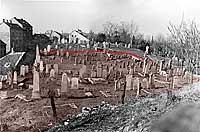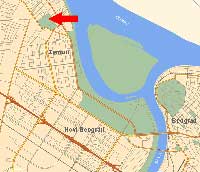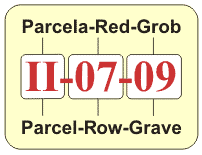 Archive photo of the cemetery with the endowed portion marked inblue
(photo David Montiljo, 1974)
|
In the early seventies of the last century the Zemun Jewish Community came under pressure to relinquish a part of the its cemetery for the institution of interment of meritorious Zemun citizens. The relevant records files show that there was persistent pressure on our community to agree to confer one part of the cemetery. Although it was general knowledge that as far as Jews were concerned, their tradition did not allow excavation and relocation of graves (in the Holy Land archeologists immediately discontinue all further site excavations if they come across a Jewish graveyard), continued pressure persisted mostly through the Association of Yugoslav Jewish Communities.
|
|
Based on the minutes of a commission consisting of experts from the Association of Yugoslav Jewish Communities, the Zemun Jewish Community, the Association of war veterans and the Burial service company we now know that on April 24, 1974 the named institutions came to a general agreement to relocate a large number of cemetery monuments. There must have been a substantial amount of resistance to the implementation of this decision since three years had to pass before the Zemun Jewish Community finally conceded to officially relinquish part of its cemetery to the municipality of Zemun. We are grateful for the photographs of Mr. David Montiljo taken in 1974 because they give us a chance to see how the oldest part of the cemetery had once looked and realize the extremity of the cultural and historical impairment it suffered. Instead of a planned relocation of well preserved monuments, what is left today are certain remnants of some thirty broken headstones and monuments that have been partially conserved and have managed to survive to this day. These remains of headstones and monuments have been concreted in three rows with no marking or explanation why they had been placed there. Unfortunately, at the time of relocation the oldest graveyard monuments, among which there was one, at the time still legible, dating from 1745, were ruined. Beside other monuments the monuments of Theodore Herzl’s predecessors were also destroyed. Consolation must be found in the fact that the monuments of Theodore Herzl’s grandfather Simon and grandmother Rivka were preserved and that the Jewish Community pays due attention to its ongoing protection and maintenance.
|



